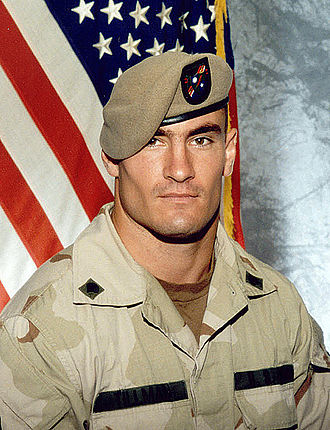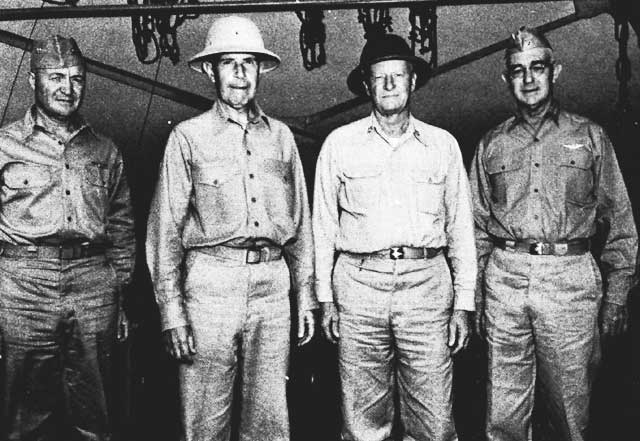
The three previous threads have dealt with the hidden friendly fire, USN doctrine & a horrid staff planning error that left far too few staffers to plan because of a grand standing USMC general/Deputy Chief of Staff in 10th Army .
"Failing to plan is planning to fail."
2/
"Failing to plan is planning to fail."
2/
This thread focuses on how unexamined CentPac & 10th Army staff assumptions in changed combat conditions turned around and bite them all in the assets.
3/
3/
The photo here shows a rock crusher operating while cranes and power shovels load CCKW dump trucks at a quarry near Omaha Beach, used by US Army Engineer units to supply stone for the construction of roads, Normandy, France, circa June 1944.
4/
4/

The tremendous amount of traffic on the roads in Normandy, as men and supplies were brought into France over the beaches, required the services of many engineer units -- w/rock crushers -- to keep the unpaved roads in good repair.
5/
5/

At places like Tarawa, Kwajalein, & Eniwetok the USMC/Army/Navy team did not have to build many roads. Atolls didn't have room beyond that needed for an air field and the port facilities to support them.
Guam was bigger, but had roads, coral & limestone to build with.
6/


Guam was bigger, but had roads, coral & limestone to build with.
6/



Nor were extensive roads built on Peleliu while the Marines were there.
Going into the Okinawa, there had literally not been a Central Pacific campaign where rock crushers had been used to combat or civil engineers support combat operations.
This built-in staff assumptions
7/
Going into the Okinawa, there had literally not been a Central Pacific campaign where rock crushers had been used to combat or civil engineers support combat operations.
This built-in staff assumptions
7/
...that CentPac & Tenth Army took into Okinawa that just were not the case.
Specifically, coral was the same everywhere in the Pacific, it was the perfect building material for roads & air fields, Okinawa had it & rock crushers were not needed.
8/
Specifically, coral was the same everywhere in the Pacific, it was the perfect building material for roads & air fields, Okinawa had it & rock crushers were not needed.
8/

The extent that mined coral and coral sand was used for infrastructure in the Central Pacific campaign can be seen in this clip from General Richardson's "Participation in the Okinawa Operation" report dated about early May 1945.
Eleven of 18 air strips were to be coral
9/
Eleven of 18 air strips were to be coral
9/
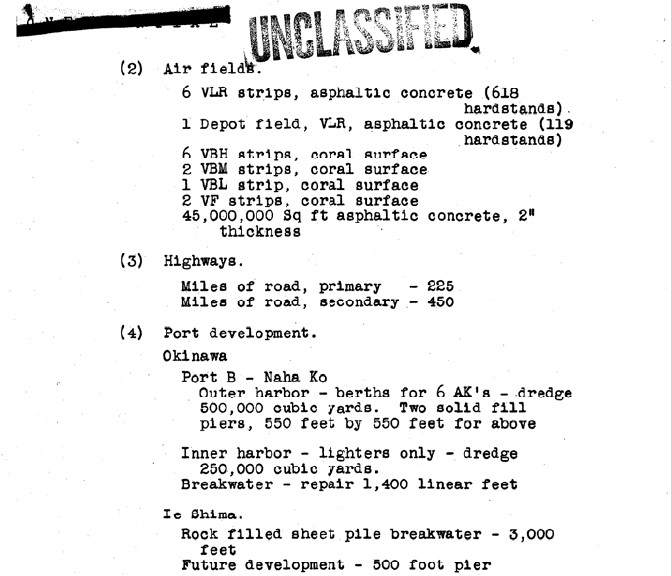
...surfaced.
Only 11 air bases with 15 strips -- one base w/strip was abandoned at war's end -- were constructed.
The 8K & 7.5K strips were B-29 w/asphalt.
The 7K strips were B-24 w/coral
The 6.5K & 6K strips were B-25/A-26 w/coral.
The 5k feet strips were Ftr w/coral.
10/
Only 11 air bases with 15 strips -- one base w/strip was abandoned at war's end -- were constructed.
The 8K & 7.5K strips were B-29 w/asphalt.
The 7K strips were B-24 w/coral
The 6.5K & 6K strips were B-25/A-26 w/coral.
The 5k feet strips were Ftr w/coral.
10/

The problems that caused these delays was that most coral on Okinawa had a high clay content.
Add lots of rain & it turned into a gooey mud.
Awase Airfield was a case in point.
en.wikipedia.org/wiki/Awase_Air…
11/
Add lots of rain & it turned into a gooey mud.
Awase Airfield was a case in point.
en.wikipedia.org/wiki/Awase_Air…
11/

The African American Seabees of the 34th NCB commenced construction of the 5000 ft Ftr airstrip on Apr 23, 1945.
Construction of the airfield was delayed by the torrential rains of late May early June so the heavy earth-moving equipment was diverted to road maintenance.
12/


Construction of the airfield was delayed by the torrential rains of late May early June so the heavy earth-moving equipment was diverted to road maintenance.
12/



The problem, as the XXIVth Corps photo report "Engineer Operations Okinawa Shima" made clear was the improved road surfaces were made of clay filled coral too.
13/


13/



The situation with the Okinawan roads were so bad in Early May 1945 that airfield pierced planks were used to build causeways for lack of "non-dissolvable" road building materials.
And was another reason Okinawa airfield development was slow.
14/
And was another reason Okinawa airfield development was slow.
14/

The Tenth Army Action Report Ryukyus - 26 March to 30 June 1945 Volume II - Engineer Staff Section XI admitted to the clay problem with some stone, but not with coral.
It also pin pointed in time when the Army Staff realized the lack of rock crushers
...but not why.
15/
It also pin pointed in time when the Army Staff realized the lack of rock crushers
...but not why.
15/

The two week before Tenth Army Staff's 'OMG moment' with the lack of rock crushers on the shipping list points to Tenth Army evaluating the last batch of US Navy Carrier group strike photos of Okinawa with low level oblique photos of the roads and vehicles on them while
16/
16/

...assembling off Leyte. AKA Where Tenth Army picked up XXIVth Corps.
Now we get to the why.
The XXIVth Corps' Leyte combat experience had been colored by a horrid mud bowl in it's supply lines.
17/
Now we get to the why.
The XXIVth Corps' Leyte combat experience had been colored by a horrid mud bowl in it's supply lines.
17/

Col Frank Gillette of XXIVth Corps staff had written an article for the US Army Staff College periodical, MILITARY REVIEW 4/1945 issue, on those muddy supply problems.
A draft of this article was given to 10th Army as detachments of US Army Signal Corps photo interpreters
18/



A draft of this article was given to 10th Army as detachments of US Army Signal Corps photo interpreters
18/

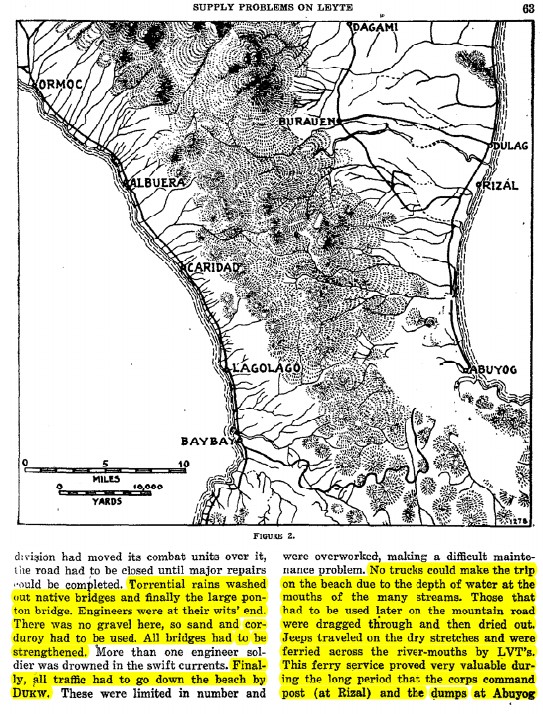

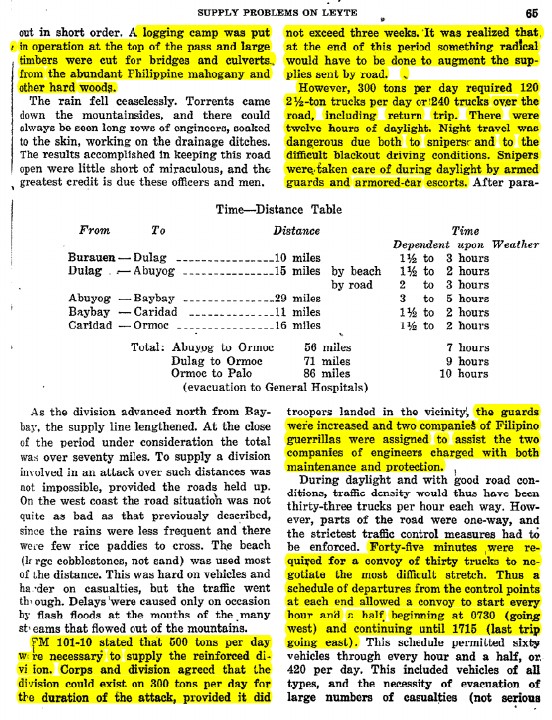
...arrived.
The G-d awful mess the US Navy had been making of US Army Signals shipping priorities for the Okinawa invasion, and the dog fight with MacArthur to get XXIVth Corps sucked away from the Philippines, had to have completely consumed the Tenth Army's
19/


The G-d awful mess the US Navy had been making of US Army Signals shipping priorities for the Okinawa invasion, and the dog fight with MacArthur to get XXIVth Corps sucked away from the Philippines, had to have completely consumed the Tenth Army's
19/



...staff attention in the months before loading amphibious shipping for Okinawa.
In particular, the Signals problem included a lack of a photo interpretation company for Tenth Army. All Tenth Army managed to get before movement was a group of photo interpretation teams for
20/
In particular, the Signals problem included a lack of a photo interpretation company for Tenth Army. All Tenth Army managed to get before movement was a group of photo interpretation teams for
20/

...US Army Divisions, XXIVth Corps and Tenth Army HQ level echelons without the command and control or reproduction capabilities of a real PI Company.
These teams were filled with any odds and sods available with any sort of PI training and arrived in Hawaii...
21/

These teams were filled with any odds and sods available with any sort of PI training and arrived in Hawaii...
21/


...just before the movement of LST's there for Leyte to pick up XXIVth Corps.
Whatever their ultimate skills, the new 10th Army P.I.'s finally evaluated the USN CV strike low level oblique photos of the roads and vehicles on Okinawa for the 10th Army staff off Leyte.
22/
Whatever their ultimate skills, the new 10th Army P.I.'s finally evaluated the USN CV strike low level oblique photos of the roads and vehicles on Okinawa for the 10th Army staff off Leyte.
22/

Then hot messages were sent to the various combat engineer battalions, groups & brigades looking for rock crushers as the low level close up photos showed the roads were much less capable than high level photos indicated.
There were no rock crushers in all 10th Army.
23/
There were no rock crushers in all 10th Army.
23/
There were no spare rock crushers in the Marianas either.
Neither the USMC nor US Navy Seebees, nor US Pacific Army had any.
The USAAF was using theirs to build B-29 strips.
24/
Neither the USMC nor US Navy Seebees, nor US Pacific Army had any.
The USAAF was using theirs to build B-29 strips.
24/
The Island Command (ISCOM) garrison force had one intended for roads that General Buckner's 10th Army staff took over on Okinawa.
One rock crusher simply was not enough against the need.
25/
One rock crusher simply was not enough against the need.
25/
The hot messages of Tenth Army drew the attention of General Robert Richardson, the commander of Army Forces Central Pacific.
He took action to see that later engineer units still staging for Okinawa from the USA & Hawaii would have rock crushers...but only by June.
26/


He took action to see that later engineer units still staging for Okinawa from the USA & Hawaii would have rock crushers...but only by June.
26/



Then it got worse.
There has been exactly one historical paper on the Okinawa campaign's military police operations published since 1945.
It was a 1995 masters thesis titled "Military Police Operations in the Okinawa Campaign" that explained how it got worse.
27/

There has been exactly one historical paper on the Okinawa campaign's military police operations published since 1945.
It was a 1995 masters thesis titled "Military Police Operations in the Okinawa Campaign" that explained how it got worse.
27/


US Army & USMC Military Police (MP) have a lot of roles. The most important for this thread was controlling military vehicle traffic.
Tenth Army did not get shipping approval from the Navy for enough MP's.
The G-4 planners of all the 10th Army units were supposed to
28/
Tenth Army did not get shipping approval from the Navy for enough MP's.
The G-4 planners of all the 10th Army units were supposed to
28/
...provide traffic circulation plans to Tenth Army MP units so they could plan their traffic control measures.
The lack of staff at Tenth Army made their planning late & pushed more work onto lower units.
So many MP unit's never got their circulation plans to plan with!
29/

The lack of staff at Tenth Army made their planning late & pushed more work onto lower units.
So many MP unit's never got their circulation plans to plan with!
29/


When the rains of May 1945 came at Okinawa. There simply were not enough MP's to control the traffic.
North-South routes 5 & 13 in XXIVth Corps eastern sector collapsed.
Route 1 in III Marine Amph. Corps western sector held on...barely.
30/
North-South routes 5 & 13 in XXIVth Corps eastern sector collapsed.
Route 1 in III Marine Amph. Corps western sector held on...barely.
30/
Unknown to the author of "Military Police Operations in the Okinawa Campaign," XXIVth Corps had replaced all it's artillery prime movers between Leyte & Okinawa with high speed tracked prime movers.
31/
31/

The LST's staged from Hawaii to Leyte to pick up XXIVth Corps included a bounty of tracked artillery prime movers.
When the XXIVth Corps MP's shut down the traffic at night on Okinawa. Many XXIVth Corps artillery units 'jumped queue' with their tracked prime movers to keep
32/
When the XXIVth Corps MP's shut down the traffic at night on Okinawa. Many XXIVth Corps artillery units 'jumped queue' with their tracked prime movers to keep
32/
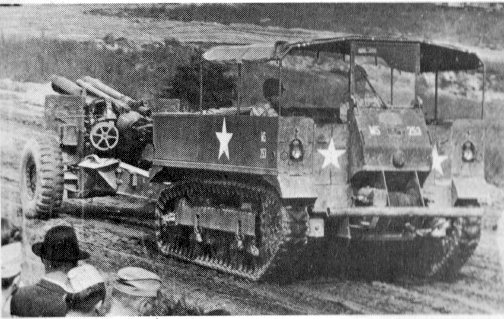
...their guns within support range.
This admirable dedication to their duty to support their infantry utterly destroyed the roads that it was the duty of MP's & Engineers to keep open to support the infantry!
33/
This admirable dedication to their duty to support their infantry utterly destroyed the roads that it was the duty of MP's & Engineers to keep open to support the infantry!
33/
It was the duty of Tenth Army staff to prevent such staff failures.
But while it was their duty, they never had the resources to carry them out.
This was the primary reason why Operation Iceberg was a logistical disaster.
/End
But while it was their duty, they never had the resources to carry them out.
This was the primary reason why Operation Iceberg was a logistical disaster.
/End
@threadreaderapp unroll
• • •
Missing some Tweet in this thread? You can try to
force a refresh








